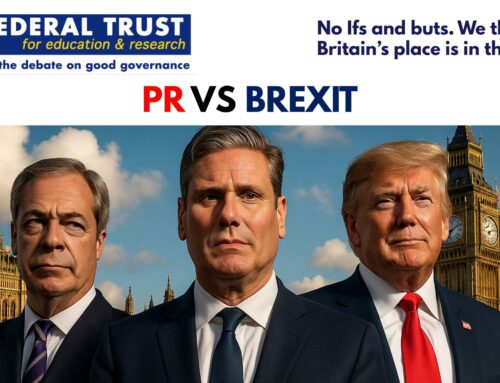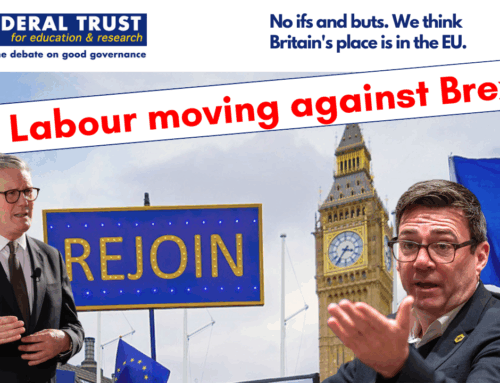Division has been central to the electoral strength of the Johnson Conservative Party. It might also prove key to understanding its potential weakness. Conservative victory in December 2019 was achieved partly through identifying a social cleavage and securing a large proportion of the support of those on one side of it. The 2016 referendum brought this already latent aspect of UK politics, cutting across established party support lines, to the forefront. It does not explain the behaviour of all voters or all the actions of the Conservative Party, but is nonetheless useful as an analytical framework.
Brexit remains central to this division, though it connects to various other issues and attitudes. Present thinking at Conservative leadership level seems to be that, to perpetuate success, far from moving on beyond Brexit, it needs to sustain or augment the schism connected to it. Hence the so-called ‘culture war’ in which debates about symbols such as flags and a yacht (royal or otherwise) that may never exist, have come to consume an inordinate proportion of public debate. In pursuing this tactic, the Conservative Party has targeted voters in areas that have traditionally not yielded electoral success for it, for instance in Hartlepool, where the Conservatives took a parliamentary seat from Labour at a by-election last month. Also aimed at such areas, in tandem with cultural rhetoric, the government has purportedly adopted an agenda of socio-economic equalisation or ‘levelling up’.
But to adopt new priorities is to downgrade (relatively or absolutely) older ones. The Chesham and Amersham by-election earlier this month saw the Conservatives lose – by a considerable margin – what had previously been a safe seat, to the Liberal Democrats. On this occasion, of the 64.5 per cent of voters who did not back the Conservative Party, a sufficiently large proportion (56.7 per cent of all who voted) coalesced around a single non-Conservative candidate. Could it be that, in energising a support base among those receptive to his messaging, Johnson has created an equal and opposite reaction against him among others?
If this possibility is in fact the case, nonetheless, at a General Election, in many seats, the Conservative vote share will be larger than it was at Chesham and Amersham, and supporters of non-Conservative parties might not feel motivated to turn out, or they might distribute between different parties in ways that facilitate Conservative victory. Here is another form of division upon which the Johnson project has thrived. At the December 2019 General Election, the Conservative Party won 56 per cent of the seats on 43.6 per cent of the total vote. A number of parties more appealing to voters on the other side of the social divide that has proved so useful to Johnson shared votes between them: notably, Labour with 32.2 per cent; the Liberal Democrats with 11.5 per cent; and the Green Party with 2.7 per cent. In the context of the Single Member Plurality or ‘First-Past-the-Post’ system, this splitting of the non-Conservative vote was key to the success of the Conservative Party. Chesham and Amersham has provided some evidence of the Johnson style of government producing a negative as well as a positive response, including in areas of previous Conservative strength. But the lack of a clear single party for alienated voters to coalesce behind, if repeated at the next General Election, will prove beneficial to the Conservatives.
Another way forward is a pact. A group of parties could agree between them to run single candidates in chosen seats, with a view to maximising the effectiveness of non-Conservative voters through giving them one clear option. For the purposes of this analysis, I assume (not necessarily correctly, but reasonably) a pact between Greens, Labour and Liberal Democrats to run single candidates in all seats in England and Wales, with each party encouraging its supporters to vote for the Pact candidate in every such constituency, whether or not from their party.
At present, the Labour and Liberal Democrat leaderships seem resistant to this idea (though some within each of these parties, as well as the Greens, have indicated they are favourable to it). But it has potential attractions for them. As is shown below, Labour would stand to make the most absolute gain from such an arrangement; but if the Pact were to be politically viable, the other two parties would need something from it. Clear runs in a significant number of winnable seats would be one attraction. Yet they would probably want something more: a commitment from Labour to support the introduction of some form of proportional representation. This proposition would be controversial within Labour. A likely precondition for a pact, then, is an internal debate within Labour leading to its reaching the conclusion that it was unlikely to win a General Election outright on its own for the foreseeable future; and – a connected realisation – that Single Member Plurality was neither justifiable nor supportive of its long term interests.
Some within Labour prefer the idea of somehow embracing Brexit as a means of regaining lost seats; or hope for the coming of a Blair-like leader who is able to broaden the party’s appeal once more, without need for a pact. (Perhaps it is possible to combine both views.) Those who find the first outlook flawed and regard the second as unacceptably quiescent and unrealistic might well come to favour a pact which included proportional representation in its platform. (But if they are to achieve ascendancy within Labour and implement this plan properly in advance of the next General Election, then time is already short.)
Aside from proportional representation, what other common agendas might a pact commit to? It would surely have to make some bold proposals. But at the same time, it would need to appeal to – or at least avoid alienating – a broad span of voters. They would range from those who find the Starmer Labour leadership insufficiently committed to socio-economic intervention to those who find the Johnson Conservative premiership excessively so. A useful starting point might be to turn the issue that the Conservative government has exploited so effectively against it. While a pledge immediately to re-join the EU might be unrealistic (not least because the EU might not be receptive in the first instance), the Pact could produce an immediate programme that included a promise to rebuild relations with the EU (including in relation to the Northern Ireland Protocol), and take steps to realign with its regulatory and customs systems. The Pact might also commit to halting the negotiation of any further economically damaging free trade agreements.
Another policy could be for the urgent introduction of measures against government corruption, and perhaps a full independent inquiry into the pandemic response (though it would be best not to assume that this latter issue will have election-winning salience). Specific interventions on the environment and international development could prove effective a voter mobilisation. The Pact might also run on a programme of constitutional reform – for instance, enhanced devolution within England, including to London; or the setting up of a convention to deliberate on change. It could pledge swiftly to implement this programme (perhaps within around eighteenth months), after which another General Election would take place. It would be held this time on a system of proportional representation (agreed before the previous Poll by the Pact parties, admittedly a challenging task). A pact would no longer be necessary, since the threat of rewarding the Conservative Party by splitting the votes of those who opposed it would be removed.
The preceding paragraph is necessarily a sketch. Execution of the programme would presumably be the work of a coalition government, made up of the Pact parties. It seems plausible that the Pact, were it to outperform the Conservatives at an election, would nonetheless need to cooperate to have sufficient numbers in the House of Commons. Labour winning an outright majority – and perhaps being tempted to break with the Pact – appears less likely. Indeed, it might be that the Pact required some kind of support from the Scottish National Party, a complicating factor. Rebellions from MPs, for instance in Labour, who remained unhappy with aspects of the Pact, could also be a problem. In theory, the House of Lords could slow down swift implementation of the programme. An important decision to be made would be whether a referendum was required on a change in the voting system. Some will claim that it is a necessity. But the Pact could make a virtue of its determination to restore the capacity of representative institutions to make choices, rather than relying on direct mechanisms of a potentially populist character. A period of coalition would be a useful experience, since at least some of the parties involved – along perhaps with new groupings – would be likely to cooperate in this way on a more regular basis once a new electoral system was established.
Here might be the most significant long-term significance of the Pact – a move away from a majoritarian (or perhaps that should be pluralitarian) culture. While the UK government at present accuses the EU of being excessively purist and lacking pragmatism in its approach (in relation to the Northern Ireland Protocol), these labels could well be attached to the nature of many political interactions within the UK, and in its dealings with the outside world, including the EU. Indeed, the Brexit project is driven by a purist, un-pragmatic attitude, especially towards sovereignty. An electoral system that repeatedly produced parliaments without single party majorities would necessitate a different conception of power. A visible change of this nature could make a future effort to re-join the EU more credible, and enable the UK to be a more constructive participant in continental integration than it was during its previous period of membership.
But whether or not such considerations have any relevance turns on the answers to some prior questions. Would the Pact work? Would voters from the three parties be willing to follow the advice to support a Pact candidate, even if not from their own party? What effect might it have on differential turnout? For instance, might non-Conservatives be more likely to vote if they thought there was an opportunity to inflict a defeat upon the governing party? Or might it encourage Conservatives, or those who simply disliked the idea of a Pact, to turn out and vote against the Pact? To some extent, the answers to these questions rest on leadership. While having effective people at senior level in a party is not a solution in itself, their ability to construct and communicate the Pact idea, and its objectives, to the public would be of considerable importance.
Inevitably, those who disliked the Pact – especially if they have something to lose from it – would denounce it as a democratic travesty and treacherous elite conspiracy. Pacts, however, are not alien to the UK system, and the Conservative Party itself has been a beneficiary of them in the past. Furthermore, the Conservatives might find the deployment of ‘culture war’ type narratives against a Pact ineffective, since they serve principally to motivate its existing supporters. The most obvious support base for the Pact comprises those who have not found such campaigning attractive, and are already actual or potential non-Conservative voters. Indeed, such techniques could serve to strengthen the cohesion of Pact support. Another electoral tactic of which the Conservatives appear to be set on making heavy use, that of directing additional public spending towards priority seats, could become harder to pursue in a Pact scenario, if the arrangement increased the number of constituencies judged to be marginal.
There is some reason to support the proposition that a Pact could succeed. I recently advised a Constitution Society project that commissioned opinion research on the subject. It modelled an arrangement between the Green, Labour and Liberal Democrat parties, in which they ran only a single candidate between them in every constituency in England and Wales. For these purposes, we assumed that Plaid Cymru were not taking part in Wales; and the Pact did not operate at all in Northern Ireland and Scotland.
Under this model, the Conservative Party would lose 58 seats as compared with 2019, down from 365 to 307. While it would have more seats than the Pact parties combined, it would no longer have a Commons majority. Labour would gain 36 on 2019 (from 203 to 239); the Liberal Democrats 14 (from 11 in 2019 to 25); and the Greens 9 (from 1 to 9). On this evidence, if a Pact can be struck, it has some hopes of success. Moreover, if the seemingly vaccine-related popularity lift the Conservative government currently enjoys starts to wane, results for the Pact could be stronger still. Political circumstances might become less favourable – especially if Johnson were challenged by a viable political force, turning his tactics against him. The differential turnout discussed above could come increasingly into play, even if Conservative voters were reluctant actually to shift their support to a Pact party. Johnson or a successor could find themselves on the wrong side of a binary he has encouraged and exploited. The Pact might then implement a change that could help transcend this divisive mode of political interaction.
Notes
For an earlier report on the survey and its implications see:
https://consoc.org.uk/wp-content/uploads/2021/06/Electoral-pacts-and-the-constitution.FINAL_.pdf
For details of the polling and its methodology see:
https://www.electoralcalculus.co.uk/blogs/ec_consoc_20210615.html






Very appealing – but what about Scotland and the Union? I hope you follow up with this. Their votes and SNP’s Westminster stance matter.